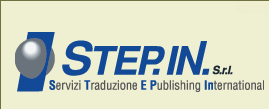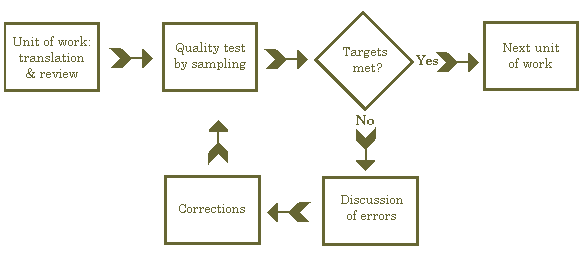

Quality and Productivity: Our Workflow
Translation
Translation and revision are carried out by highly skilled translators assisted by software and hardware specialists.
Workflow organization and control have been carefully planned in order to handle very large quantities of material to be translated. A working method relying on translation units of work or cycles has been adopted: the whole translation package is divided into smaller text assignments to be translated, proofread, revised, and quality-tested. Each text assignment is submitted to intermediate quality checks, so that corrective actions can be taken before the translation process is completed. Before starting, it is recommended that the customer appoint a coordinator to handle technical and administrative problems that may arise. The following table shows the tasks related to the translation process.
Before starting
Text is analysed to detect specific and recurrent terminology. A list of terms is then created and submitted to the customer-appointed coordinator for approval. Terms will be therefore entered into an on-line glossary which will be available to translators. This ensures consistency throughout the translated package.
Text assignments
Depending on the delivery date agreed upon, the whole translation package is divided into smaller units of work.
Setting up work teams
Work teams are set up according to quality and quantity of the material to be handled. Generally, each work team is made up of:
- Two or more translators.
- A language specialist who coordinates the translators, checks the works in progress, and ensures that translation is correct.
- A system engineer or a hardware or software specialist who, assisted by the language specialist, ensures the validity of the technical contents.
Translating text assignments
The following chart shows the translation and revision cycle performed for each text assignment.
- The translator translates, reviews, and corrects the first assignment.
- The language specialist tests the translated unit of work to verify that the expected quality targets have been met.
- If the expected quality targets have been met, the translator is assigned a second unit of work.
- If the expected quality targets have not been met, the translated unit of work is returned to the translator who is expected to review it according to the guidelines dictated by the language specialist.
Translation cycle

Sampling Method
In order to check large quantities of material, a method of quality testing by sampling has been adopted. For each unit of work a statistical program is used to determine the number of pages of the sample to test in view of verifying that the expected quality targets have been met.
Quality Testing
The translation must comply with the following rules:
- Concepts must be rendered without altering the meaning implied in the original text. The translated text should convey the same information as provided in the original text.
- Italian translation must be smooth and easy to read.
- Terminology should be consistent throughout the whole translation.
Quality standards have been fixed in terms of error occurrences per standard page (250 words).
Error Definition
Errors fall within the following categories:
Severity 1:
Errors prompting the user to perform actions causing damage to data, programs, systems, or people.
Severity 2:
Translation, consistency and terminology errors that do not produce the same fatal effects as severity 1 errors.
Severity 3:
Syntax, grammar, spelling and typing errors that do not produce the same fatal effects as severity 1 errors.
The quality standards fixed with respect to error occurrences in the sample are the following:
Severity 1 errors: 0
Severity 2 errors: no more than 1 every 6 standard pages
Severity 3 errors: no more than 1 every 4 standard pages







